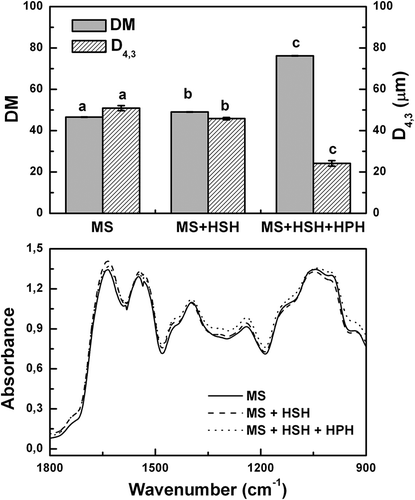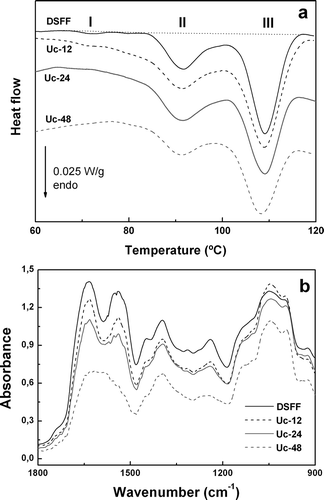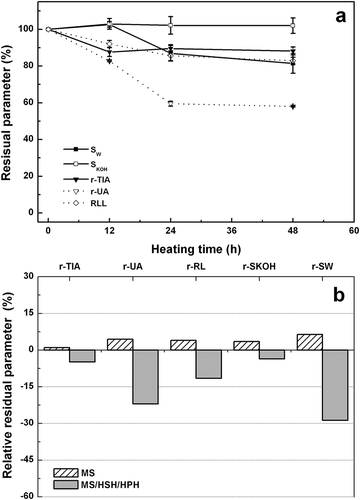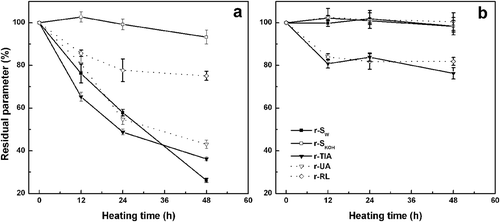Figures & data
Table 1. Sample nomenclature for heated samples prepared from defatted soy flakes flour (DSFF).
Figure 1. a) Dispersible material (DM, expressed as g of dispersible solids per 100 g total solids), De Brouckere mean diameter (D4,3) values and b) FTIR spectra for or unheated DSFF aqueous dispersions prepared using various dispersing treatments. MS: magnetic stirring, HSH: high-speed homogenization and HPH: high-pressure homogenization. Mean values with different lowercase letters indicate significant differences between aqueous dispersions treated with different dispersing treatments (p<0.05).

Figure 2. a) DSC thermograms (30.0 g sample/100 g in 1.0 mol/L NaCl) for defatted soy flakes flour (DSFF control sample, without any previous heating) and heated Uc-12, Uc-24 and Uc-48 samples (62 ± 2 °C, HR = 79% for 12, 24 and 48 h, respectively); b) FTIR spectra for DSFF, Uc-12, Uc-24 and Uc-48 samples. Sample nomenclature was defined in . : a) DSC thermograms (30.0 g sample/100 g in 1.0 mol/L NaCl) for defatted soy flakes flour (DSFF control sample, without any previous heating) and heated Uc-12, Uc-24 and Uc-48 samples (62 ± 2 °C, HR = 79% for 12, 24 and 48 h, respectively); b) FTIR spectra for DSFF, Uc-12, Uc-24 and Uc-48 samples. Sample nomenclature was defined in .

Table 2. DSC and FTIR parameters for heated DSFF aqueous dispersions (62 ± 2°C, without and with relative humidity control, RH = 79%).
Figure 3. a) Effect of heating time on residual parameters (%) for heated DSFF aqueous dispersions treated by MS/HSH dispersing treatments (10.0 g total solids/100 g, 62 ± 2 °C, RH = 79%) (Uc samples). Residual parameters were: trypsin inhibitor activity (r-TIA), urease activity (r-UA), reactive lysine (r-RL), protein solubility in water (r-SW) and 0.2 g/100 g potassium hydroxide solution (r-SKOH); b) Relative residual parameters (%) for DSFF aqueous dispersions treated by MS and MS/HSH/HPH, heated for 24 h (10.0 g total solids/100 g, 62 ± 2 °C, RH = 79%), corresponding to Mc-24 and Vc-24 samples, respectively; c) Idem b) for 48 h, corresponding to Mc-48 and Vc-48 samples, respectively.

Figure 4. a) Effect of heating time on residual parameters (%) for heated DSFF aqueous dispersions treated by MS/HSH dispersing treatments (10.0 g total solids/100 g, 62 ± 2 °C without RH control) (U samples). Residual parameters were: trypsin inhibitor activity (r-TIA), urease activity (r-UA), reactive lysine (r-RL), protein solubility in water (r-SW) and 0.2 g/100 g potassium hydroxide solution (r-SKOH); b) Relative residual parameters (%) for DSFF aqueous dispersions treated by MS and MS/HSH/HPH, heated for 12 h (10.0 g total solids/100 g, 62 ± 2 °C without RH control) corresponding to M-12 and V-12 samples, respectively.

Figure 5. a) Effect of heating time on residual parameters (%) for heated DSFF solids samples: a) 62 ± 2 °C, RH= 79% and b) 62 ± 2 °C, without RH control. Residual parameters were: trypsin inhibitor activity (r-TIA), urease activity (r-UA), reactive lysine (r-RL), protein solubility in water (r-SW) and 0.2 g/100 g potassium hydroxide solution (r-SKOH).

Table 3. DSC and FTIR parameters for DSFF solid samples (62 ± 2°C, without and with relative humidity control, RH = 79%).
